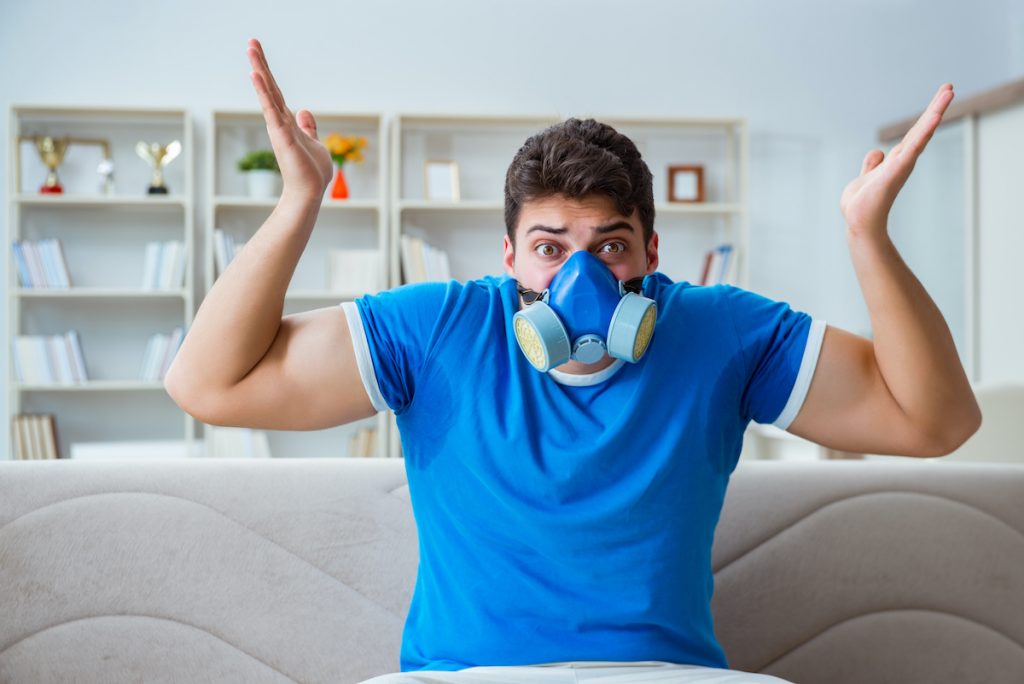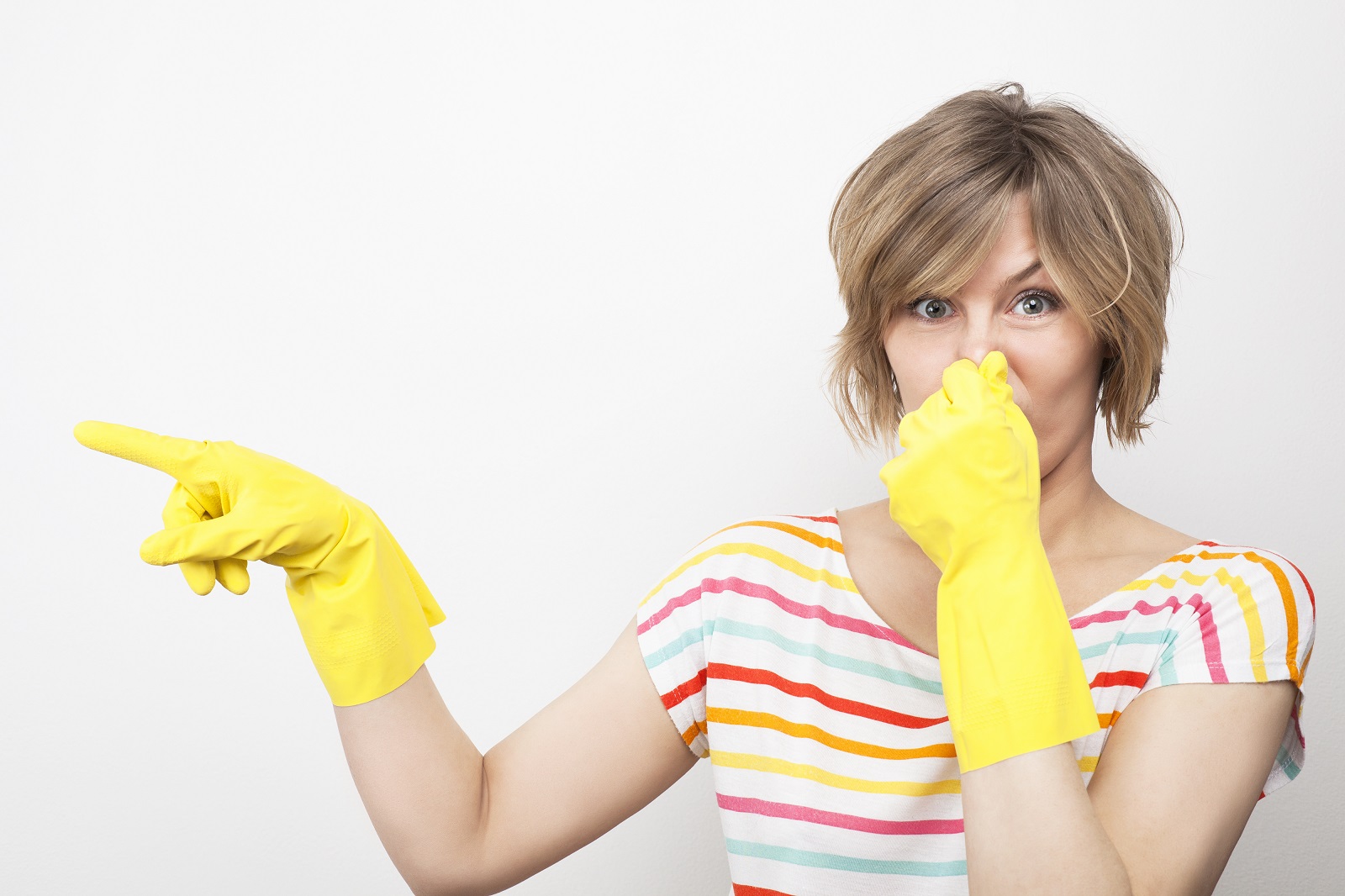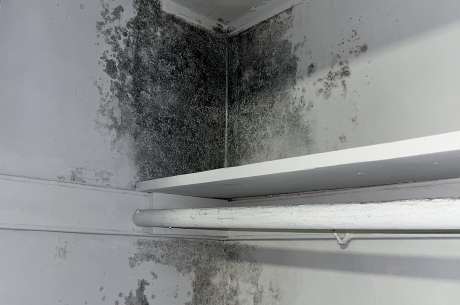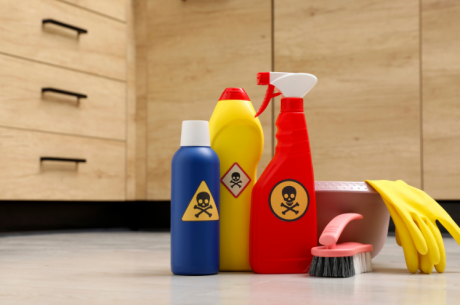Understanding Unpleasant Odors
There are many reasons why an unpleasant smell lingers in your house. A burning smell could indicate electrical issues that require immediate attention. Some smells signal danger, like mold or decomposition, which often requires professionals. Others are not that serious. Learn about what may be causing your unexpected smells. Then, find the best solutions for home odor removal below.

How to Neutralize Foul Odors
What smell are you trying to get rid of:
2. My house smells like tobacco smoke
3. My house smells like pet urine or skunk spray
4. My house smells like something is decomposing in it
5. My house smells but it could be anything
1. Why Does My House Smell Musty?
Musty odors often signal mold growth. They come from water damage or too much humidity in your home. Mold thrives in damp, warm, and dark places and presents several health risks.
Mold Exposure Symptoms
Getting rid of mold neutralizes the odor and defends occupants from health risks caused by mold exposure. People sensitive to mold may have allergies. This may cause symptoms like sneezing, a runny or stuffy nose, itchy eyes, wheezing, coughing and skin irritation. Mold exposure can also cause irritant reactions, with symptoms like those of a mold allergy.
For proper odor removal in your house, the affected area must be dried, and the mold must be properly removed.
- You might like: How to Get Rid of Mold on Your Bathroom Ceiling
Tips for Removing Foul Odors Caused by Mold
- Check damp places in your home that could support mold growth. Remember, mold can hide. If you can’t find the mold, hire a restoration company with non-invasive moisture meters to find hidden mold.
- Once you find the affected area, clean it by scrubbing the surface with detergent and water. Since bleach cannot penetrate all surfaces to kill the mold roots, bleach is not recommended for mold removal on porous surfaces. Next, dry the area using ventilation and dehumidifiers. Make sure the area is dry before repainting or reconstruction.
- If the bad smell comes from the carpet, first fix the humidity issue. Then, to deodorize your carpet, spray it with one cup of white vinegar and two cups of water. Next, sprinkle some baking soda on the carpet and wait a few hours. Stubborn odors may require a second round. (Make sure you spot test first to avoid potentially damaging delicate materials).
Contact a professional mold remediation company for any mold removal task. Our experienced technicians use industrial-strength machines to tackle the mold. Also, they use dehumidifiers, air-moving machines, and fans to dry the area thoroughly.
2. My House Smells Like Tobacco Smoke
How Tobacco Smoke Affects Your Home
Tobacco smoke releases odorous substances that stick to every surface where smoking occurs. Regularly replacing air filters can help prevent the buildup of unpleasant odors caused by smoke particles. Cigarette smoke also gets into more odor-absorbing objects, such as carpets, upholstery, bedding, clothes, etc. Additionally, a building’s HVAC system can carry smoke odor and chemicals throughout the structure. Tobacco residue is tough to remove and requires professional equipment and services. But if you want to try DIY cleanup, here are a few tips to remove smoking odors (and vape odor, too).
Long-Term Cigarette Odor Removal Solutions
For cigarette smoke odor removal, you must thoroughly clean the odor-causing residues from every surface and corner of the home:
- First, ventilate. Open all windows and doors and let in as much fresh air as possible.
- Clean or replace all your air filters, furnace filters, and AC filters.
- Clean walls and ceilings using products containing ammonia or glycol (common in household cleaners). These ingredients help neutralize bad odors. Let the walls dry, and then check for remaining odors. DO NOT mix ammonia with other cleaners, especially bleach as it could cause toxic fumes!
- If you still smell cigarette odor, repaint the walls and ceilings with latex paint. Before painting, use a sealant designed to lock in smoke odors.
- Clean everything in the home–floors, windows, carpets, furniture, upholstery, draperies, blinds, and other household surfaces and fixtures. If the smoke is too difficult to remove, hire a professional cleaning company.
Short-Term Cigarette Odor Removal Solutions
For inexpensive, short-term solutions, try these tips:
- Use an air purifier.
- Sprinkle baking soda on the carpets. Leave it on overnight to absorb the bad smell. Vacuum it the next day.
- Put saucers of white vinegar around the house. Leave them overnight to neutralize the smell.*
- Get indoor plants. They can absorb indoor pollutants.
- Place small bowls of coffee grounds around your home.*
- Use candles (scented or non-scented).
- Leave orange slices and peels around the home.*
- Place pineapple slices around the room (and close doors and windows for 24 hours).*
- Put bowls of activated charcoal around your home.*
*Please be careful where you place these items. They may harm children and pets if eaten.
In a pinch, using air fresheners and essential oils temporarily masks odors in your home. When an unpleasant odor arises, simply reach for your favorite essential oil to provide an immediate fragrance that both masks the odor and introduces a delightful scent.
Please note that air fresheners and oils do not eliminate odors. They only mask odors and do not address the underlying problem.
How Professionals Perform Smoke Odor Removal from a Property
Since tobacco residue is present throughout the affected area, removing it is often difficult. There is no magic formula just to whisk away the residue and smell.
The only effective way to remove tobacco smoke residue is to clean and seal all structural surfaces. Restoration specialists start eliminating tobacco smoke odors by cleaning all surfaces. The cleanup includes deodorizing agents to help eliminate the tiny particles of smoke.
Once the technicians clean the visible surfaces, specialized equipment is often necessary to remove the last odors that are not easily accessible (such as inside walls or joints). This usually involves hydroxyl or ozone generators — professional equipment that effectively breaks down odor-causing molecules through oxidation.
The next step is to seal the surfaces with a product designed to seal in smoke residue. This sealant can lock in stains and odors. Finally, surfaces will be ready to paint, refinish or apply new coverings.
What about the soft items? Upholstery, bedding, draperies, and clothes absorb odors and are often easily damaged. Because of this, they are difficult to restore successfully and may require specialists. Often, it is easier and more cost-effective to replace these.
For cigarette smoke odor removal, call the professionals!
For effective and quickest removal of tobacco smoke odor in your home, hire a professional restoration company like PuroClean. We provide complete smoke cleanup sanitation, professional deodorization, and duct cleaning.
3. My House Smells Like Pet Urine or Skunk Spray
Skunk spray and severe urine odors can be some of the most upsetting when they affect your home. Controlling these odors can be difficult, but it can be achieved. Here are tips on how to neutralize odors correctly.
How to Remove Pet Urine or Skunk Smell
- Nonporous surfaces—If urine or skunk spray is on a nonporous surface, like metal or plastic, thorough cleaning is the first step. That may be enough. Since the odor-causing residue contains natural oils (the cause of the smell), use a strong detergent. Warm water and strong detergent should be adequate and quick. After washing, rinse the surface. Repeat the process if the smell is still there. Make sure to rinse to wash away any residue.
- Porous surfaces—If urine or skunk odor is on a porous surface, like carpet, upholstery, or particleboard, cleaning is the first step. Clean these the same way as nonporous surfaces. If your efforts fail or the task is too much, call a restoration company. Note that carpets and pads with excessive urine damage create a biohazard condition and should usually be removed and discarded.
- Semi-porous surfaces—As explained above, Semi-porous materials, like most wood, are also cleaned with water and detergent. The detergent should be allowed to penetrate the surface to help neutralize the odor. However, if urine or skunk spray heavily damages the wood, you must dispose of it. Get help from a restoration company. It will improve your odds of cleaning semi-porous materials.
How to Eliminate General Pet Odors:
- Freshen up furry companions with a bath. Regular washing banishes dirt and smells, keeping pets clean and happy. You can also clean or wash pet bedding.
- Frequent brushing prevents shed hair from reaching your furnishings. Regular grooming helps maintain a clean smell in your home.
- Wash your dog using pet-safe shampoos specifically formulated for dogs. These shampoos are designed to clean without causing harm or irritation. If you’re dealing with specific issues like skunk spray, there are specially formulated products available for that purpose as well.
- Empty the cat litter boxes. Clean it by pouring in a half-inch of vinegar and a little baking soda. Add water, stir and let it soak. Afterward, pour out the liquid, wash, rinse and let it dry.
- Vacuum and clean furniture and carpets often. Use pet-safe products, following label instructions carefully. Keep your home tidy without risking your furry friends’ health.
- Baking soda is commonly used to remove odors. Sprinkle baking soda on carpets and fabrics. Leave it on for 15 minutes (or more), and then vacuum. Enzymatic cleaners are often effective for pet urine odors too.
- Use air filters to recycle your household air. HEPA air filtration systems are recommended. Change HVAC filters monthly to provide the best air purification possible.
- Clean the pets’ useable objects (toys, food containers, etc.) weekly. This will improve the smell in your home and your pets’ health.
After applying these tips, your home should smell clean, or at least not like a wet dog. But if the problem persists, call PuroClean. Our biohazard cleanup pros use specialized products and tools to complete deodorization.
4. How to Deodorize a House Affected by Decomposition Odor
Some of the most foul odors come from the decomposition of human or animal bodies. Check out our tips to remove this foul odor.
- Dead body odors — When human death enters the equation, seek professional assistance. After the authorities remove the body, professional biohazard technicians will clean the area following OSHA’s rules for Bloodborne Pathogens and Other Potentially Infectious Materials (BOPIM). These regulations specify the training, equipment, and products to use. The protocols also cover safety issues. Professional trauma cleanup companies not only follow regulations but also use specific, approved methods and products to safely decontaminate the areas.
- Dead animal odors — If the decomposition source is a small animal, like a rodent, the cleaning is like removing pet urine or skunk spray. First, clean and sanitize non-porous and semi-porous material while wearing protective gear. Discard damaged absorbent items. Semi-porous and nonporous materials must be thoroughly cleaned and sanitized with a disinfectant. Over-the-counter disinfectants can be effective and will ensure a clean and sanitary surface. Look for an EPA-registered disinfectant appropriate for the specific situation.
5. How to Remove Other Smells in Your Home
Bad odors also linger in places like your kitchen, bathroom and basement. These unpleasant odors permeate carpets, fabrics, and your pets’ favorite spot. Here are budget-friendly tips to remove bad odors from your home.
- Remove the source of the smell. To truly fix the odor issue, find the problem and fix it. For example, repairing plumbing leaks could stop the musty smells in your home.
- Wash surfaces such as countertops, tables, hard floors, and walls. Use your favorite cleaner or a mixture of half water and half white vinegar.
- Empty trash cans: Emptying your trash cans regularly is essential for maintaining a fresh-smelling home.
- Make it a habit to remove the trash bag as soon as it fills up, especially if it has food scraps or other smelly items.
- Also, use strong trash bags. They help avoid leaks and spills. Spills can cause odors to last.
- Clean your trash can with warm, soapy water and a disinfectant if you notice any unpleasant odor.
- Clean carpets and fabrics:
- Baking soda is a simple way to neutralize carpet odors. After the carpet is dry, sprinkle baking soda on it. Let it sit overnight. The next day, vacuum to remove the baking soda.
- White vinegar can absorb odors on upholstery. Mist upholstery with vinegar from a spray bottle. Wait until the vinegar air-dries. Once it has dried, the strong smell of vinegar and musty odors will be gone.
- Fight kitchen smells:
- Fridge: Keep an open box of fresh baking soda in the refrigerator to absorb odors. Wipe down shelves using hydrogen peroxide. Be sure to remove spoiled food.
- Garbage disposal: Grind some ice in the garbage disposal, then sprinkle it with Borax and rinse it thoroughly with water so no residue can come in contact with food that will be eaten. Also, with the disposal turned off, pop out the plastic disposal collar that funnels items into the disposal and clean it with soapy water to remove built-up debris and grease.
- For fish and other food smells, boil a cup of vinegar on the stove. (Take care to ensure proper ventilation when boiling vinegar. The strong smell can be overwhelming). The vapors quickly absorb smells. Then, wipe down the cabinets with soap and a damp cloth.
- Remove bathroom odors:
- Toilet: Add one cup of white vinegar into the bowl, wait five minutes, then scrub and flush.
- Sink drain: Mix half a cup of bleach and half a cup of water and pour it down the drain. Let it stand for an hour, then rinse with water. If you have a septic system, limit the use of bleach in the drain.
- In the laundry room:
- Empty your laundry basket regularly: Avoid letting dirty laundry pile up too long. Move dirty clothes from the basket to the washer often to prevent the bad smell.
- Wash dirty laundry promptly. This is especially true for damp items like towels or gym clothes. This prevents mildew and other sources of bad smells from developing.
- Clean your laundry basket to remove any lingering odors. A quick wipe-down with warm, soapy water and a disinfectant can make a big difference. It will keep your laundry room smelling clean and fresh. Don’t forget to clean your laundry room trash can, too!
- Keep your washing machine odor-free. Leave the door open after each use to allow it to air out. Run an empty cycle, adding hot water and a cup of white vinegar or baking soda once a month to keep bad smells at bay. This routine helps prevent mold and mildew from growing inside your machine.
If Nothing Else Works, Call for Professional Home Odor Removal
Following these tips can help clear up odors in your home. For professional deodorization services for homes affected by tobacco smoke, fire, or mold, call PuroClean of Matawan at (732) 351-2442. Our restoration experts are ready to come to your property’s rescue 24/7!




 PuroClean of Matawan
PuroClean of Matawan